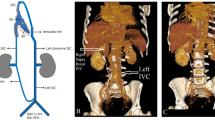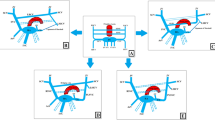Abstract
Left-sided inferior vena cava (IVC) is a rare malformation of IVC. We report an 11-year-old boy with hematuria and left lower back pain due to compression of the left-sided IVC between the aorta and the superior mesenteric artery. Ultrasonography and magnetic resonance imaging clearly revealed this anatomic anomaly.
Similar content being viewed by others
Avoid common mistakes on your manuscript.
An 11-year-old boy was admitted to hospital with intermittent gross hematuria and left lower back pain. His height was 160.4 cm and his weight was 43.0 kg. Urinalysis identified hematuria (> 100 red blood cells per high-power field), but no proteinuria. Abdominal ultrasonography revealed that the infrarenal segment of the inferior vena cava (IVC) was positioned on the left side (Fig. 1a). After collecting blood from the left renal vein, the left-sided IVC crossed the midline and was compressed while passing between the aorta and the superior mesenteric artery (SMA) (Fig. 1b). The anteroposterior diameters of the left-sided IVC at the dilated caudal portion and at the narrowest portion were 12.2 mm and 1.7 mm, respectively. The angle between the SMA and the aorta was measured at 24°. Magnetic resonance angiography showed that a collateral vessel ran upwards from the dilated caudal left-sided IVC (Fig. 2). Taken together, these imaging and clinical findings are indicative of nutcracker syndrome with left-sided IVC.
References
Mayo J, Gray R, St. Louis E, Grosman H, McLoughlin M, Wise D. Anomalies of the inferior vena cava. AJR. 1983;140:339–45.
Bass JE, Redwine MD, Kramer LA, Huynh PT, Harris JH Jr. Spectrum of congenital anomalies of the inferior vena cava: cross-sectional imaging findings. Radiographics. 2000;20:639–52.
Author information
Authors and Affiliations
Corresponding author
Ethics declarations
Conflict of interest
The authors have declared that no conflict of interest exists.
Research involving human and/or animal rights
This article does not contain any studies with human participants or animals performed by any of the authors.
Informed consent
Informed consent was obtained from all individual participants included in the study.
About this article
Cite this article
Ueda, Y., Aoyagi, H. & Okamoto, T. Left-sided inferior vena cava with nutcracker syndrome. Clin Exp Nephrol 23, 425–426 (2019). https://doi.org/10.1007/s10157-018-1636-5
Received:
Accepted:
Published:
Issue Date:
DOI: https://doi.org/10.1007/s10157-018-1636-5






